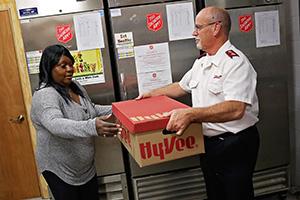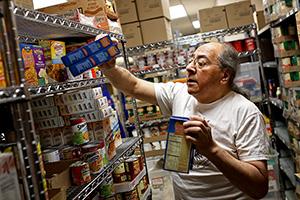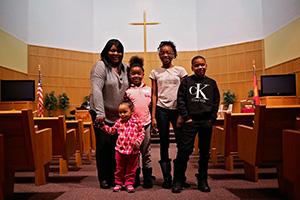Who visits Salvation Army food shelves, and why?
Since fall 2015, Delores Jones (pictured below) has suffered through a heartbreaking series of hardships: Cancer. Chemo. Radiation. Heart problems. A house fire that destroyed everything she owned, including her dog.
 To boot, she has endured these adversities while caring for four of her grandchildren full-time.
To boot, she has endured these adversities while caring for four of her grandchildren full-time.
Not surprisingly, Jones has needed some help during the past year, including food, clothing, and counseling from The Salvation Army.
“We have been tremendously blessed by The Salvation Army,” said Jones, who is now back on her feet.
Jones and her grandkids are just a few of the people who visit the Twin Cities Salvation Army’s eight local food shelves each year. But who else visits our food shelves? Why do they need help? Are they satisfied with the services we provide?
The Salvation Army has discovered answers to these and other questions via a survey we distributed at our Twin Cities food shelves in June 2016. Of the nearly 2,300 guests who visited that month, 626 of them chose to complete the survey.
We conducted the survey “to obtain a clearer picture of who we’re helping and how we can improve our services for people and families experiencing food insecurity,” said Terry Hildebrandt, Twin Cities Salvation Army social services director.
Here are some of the key findings:
Many children served
The 625 survey respondents represented a total of 1,702 household members, and just over 40 percent of the household members were children ages 17 and under.
 “These numbers show that well over a third of the food we distribute goes to kids,” Hildebrandt said.
“These numbers show that well over a third of the food we distribute goes to kids,” Hildebrandt said.
That’s about 10 percent higher than the national average. Of the 42 million Americans who live in food insecure households, 13 million (30 percent) of them are children, according to FeedingAmerica.org.
The fact that our food shelves serve so many children underscores why most of our operation centers also offer youth programs, along with counseling and financial assistance programs for their parents.
“Oftentimes, our food shelves are a gateway to other Salvation Army programs,” Hildebrandt said. “These programs keep children safe and healthy while providing the resources necessary to lift families out of poverty.”
Usage and demographics
The two largest racial/ethnic groups who used our food shelves included African American (38 percent) and Caucasian (28), followed by Hispanic (10), Asian/SE Asian/Pacific Islander (9), and multiracial (8). Other groups included African, American Indian, Middle Easter, and Eastern European.
 Thirty-two percent of respondents said they use our food shelves 10 to 12 times per year, followed by:
Thirty-two percent of respondents said they use our food shelves 10 to 12 times per year, followed by:
- 1 to 3 times: 28 percent
- 4 to 6 times: 19 percent
- 7 to 9 times: 21 percent
A third of respondents stated that they visit one or more other food shelves per month. (Salvation Army food shelf guests are allowed one visit per month.)
About 40 percent of respondents received food stamps and/or social security benefits. Twenty percent received no government benefits.
Takeaway #1: Creating dependency?
The survey results raised two important questions: 1. Are our food shelves creating dependency? 2. Are guests using the food shelves to supplement their income instead of coming only in times of crisis?
The Salvation Army is working hard to ensure that the answer to both of those questions is no. In recent years, we have increased our efforts to lift families out of poverty through a Salvation Army initiative called Pathway of Hope. Through this program, Salvation Army caseworkers and social workers provide struggling families with long-term, intensive case management to lead them to stability.
 The program is working for Delores Jones (pictured), the woman who was mentioned earlier. Months after enrolling in Pathway of Hope, she is now stable, has her own car, and is focused on finding a steady job. Not only that, she has become an advocate at a shelter for battered women, and she is studying to become an ordained minister. She exercises every morning and has lost 30 pounds, with plans to lose 30 more.
The program is working for Delores Jones (pictured), the woman who was mentioned earlier. Months after enrolling in Pathway of Hope, she is now stable, has her own car, and is focused on finding a steady job. Not only that, she has become an advocate at a shelter for battered women, and she is studying to become an ordained minister. She exercises every morning and has lost 30 pounds, with plans to lose 30 more.
“From where I started to where I’m at now is just amazing,” she said. “The Salvation Army has given me love and support. It’s a brand new pathway.”
Most Pathway of Hope participants find out about the program through our food shelves.
Takeaway #2: More food options?
The survey indicated there is room for our food shelves to improve the types of foods they offer. In response to an open-ended question asking which foods people would like to see more of, the majority of respondents asked that more fruits be available.
 While our food shelves strive to offer as many fresh foods as possible, the items are sometimes in low supply due to their high expense.
While our food shelves strive to offer as many fresh foods as possible, the items are sometimes in low supply due to their high expense.
“Offering fresh foods will always remain a top priority,” Hildebrandt said. “We are doing the best we can through our rescued food program, which allows us to offer fruits, vegetables, meats, and other healthy perishables that we cannot always afford to buy in large quantities.”
The majority of respondents indicated they were satisfied with their experience at Twin Cities Salvation Army food shelves. At least 90 percent of them replied “Agree” or “Strongly Agree” to six statements such as “The process is easy,” “I feel welcome,” and “Foods from my culture are available.”
Last year, the Twin Cities Salvation Army’s eight food shelves distributed more than 100,000 bags of groceries to thousands of individuals and families, including one man who recently sent us a touching thank you letter.
“Through (your food shelf), my family had a variety of good foods to eat, and we were able to balance our monthly budget while I was on unemployment,” the man wrote. “Keep up the Lord’s good work.”
Please join The Salvation Army by volunteering or making a donation to support your local community.
